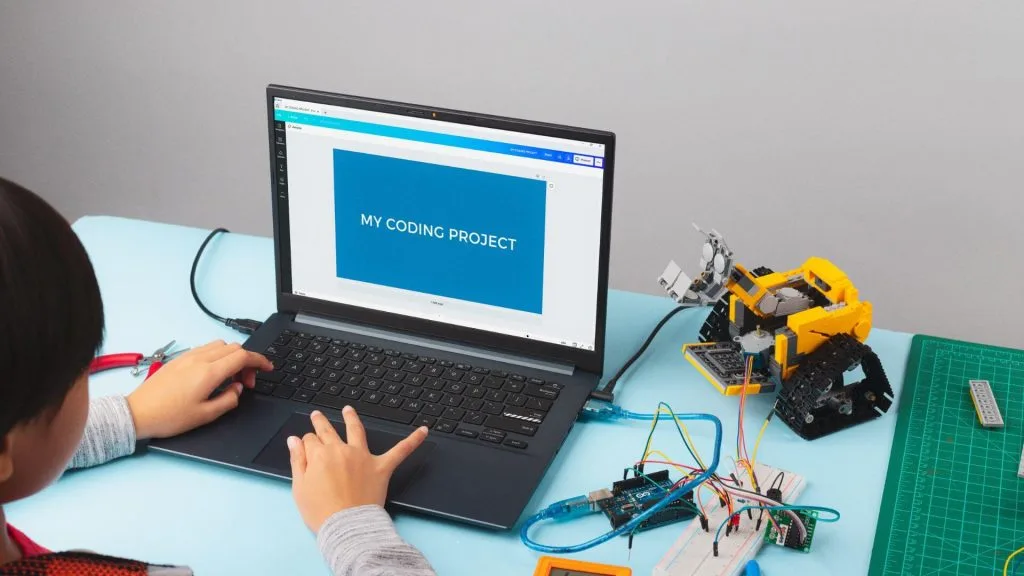CodeMonkey is an online subscription service that teaches young people how to write programming code. There are also accounts for parents to help teach their kids how to code and accounts for teachers to help them educate classrooms of children.
The child-friendly aesthetic suggests the service is aimed at younger children from the ages of 8yrs old to 16yrs old. It tries to capture the Roblox, Minecraft, and Gamer-mod trends by teaching courses that have coding games attached, similar to the always popular Codakid. As a mixture of traditional learning courses and gamification, the service hopes to capture the attention of younger people and keep them engaged while they absorb the coding lessons.
Courses, Languages, and Game-Based Learning
The CodeMonkey subscription service has courses set up for children who are learning independently. There are joint courses that parents and children can undertake, and there are teaching tools that help teachers educate a class.
The CodeMonkey looks on the surface like it is teaching children written controls for in-game courses and games. It looks that way on the surface, but as the courses and/or games progress, the instructions move closer to being code and further away from being inputted instructions. This is the trick and gimmick of several of the courses and games. Starting out simply with the desired goal, and subtly teaching the child to achieve that goal using coding.
Game-based learning is as it sounds. Various games offer simple objectives, and the answer is often some sort of coded input. It takes inspiration from the traditional gamification model where children are taught a concept. They are then given things to memorize. Finally, they are tested on their knowledge and understanding by how well they do in the game. As with most types of testing, the act of playing the game also re-enforces knowledge and helps the learning process.
Should Parents Teach Coding To Their Kids?
It is true that teaching coding and programming isn’t as important as teaching your kid to swim or ride a bike. However, teaching a child to code can become a bonding exercise. It may open up new pastimes for your child. Also, it is something that can be added to a CV later in life.
The key issue is the removal of pressure. Some kids will take to coding with no problem, and others will pull away from it. If your child pulls away, it is very important that you do not pressure your child into coding. It will scare him or her away for life.
Some kids are not happy to sit at a computer for hours and work on programming code. Some kids want more energetic pass-times. If you back off and do not push your child to learn to code, then they are more likely to return to coding later in life. Teens are often happier to take up more sedate pass-times like coding.
CodeMonkey seems to be aware that some kids simply don’t take to coding. This is why they let you start for free (with no need to add a credit card). If your child doesn’t take to coding, then cancel your free subscription and try again in a few years.
The Strongest Part of the Service
Hands down, the best part of the CodeMonkey service is the games. If you ever played the first Angry Birds game before it was remastered, then the games have that same variety of wide-eyed broadly drawn feel.
The games are the best part of the CodeMonkey service, which is probably why their website and marketing push them so hard. On their own, the games can be a little tricky as you progress, which is fine for a self-motivated student. However, the game is best utilized by parents and teachers. Helping guide a child through the games, allowing them to take the reins while gently being able to nudge at solutions is perhaps one of the best-guided learning methods available for younger people who wish to learn about coding.

The Weakest Part of the Service
This has to be the teacher’s tools, and this is not a point made lightly because they are still pretty good. The reason they fall a little flat is that the CodeMonkey developers haven’t studied the wide variety of classroom situations and how they may develop. Instead, they have thrown in the tool after tool with the hopes a teacher will pick the ones most suitable. However, these days, modern teachers of younger children are used to an all-in-one centralized solution.
A more centralized, perhaps group-guided learning platform may have been a better way to teach children in a group. Perhaps a system where the teacher runs through the process step by step and can see when each child has completed each step before moving on. The system that CodeMonkey is fine, but it requires that the teachers have a lot of control and supervision over the class, and that is not always possible with smaller children in bigger class sizes.
The Parent and Child System
Children are taught through courses and games, and a parent should try to stay involved while also stepping back. It is very easy to get caught up in the games and start doling out the answers as a parent; essentially taking over from the child.
The best part about the parent and child approach is those times when your kid slightly misunderstands something and you are there to fix the problem. For example, a child may see the solution that is “Obvious” to the child but is in fact wrong. Often it is because the kid missed a step, which you can rectify, but there is a slew of other potential problems.
A common problem is that the kid blames the computer for not doing what it is told. Other times, the kid loses track of the process and becomes completely lost. The great thing about these moments is that if the kid was alone, then he or she would have quit at these points. However, with a parent there to help, the child may carry on and continue to enjoy the process.

The Cost and Prices of CodeMonkey
If it were a spoken language service, you may be tempted to use the free trial to swipe all the courses and use them later yourself. However, CodeMonkey has courses and games, most of which are difficult to steal.
It is far easier to pay the subscription and work through each course in time and play the games as it goes. Should you buy a subscription as a gift for a child? This is a tricky one. If your child is interested in coding for some reason, then this may not be what they are actually asking for, they are probably asking for a way to modify or program a game that their friends are interested in.
Kids who do best on this system are the ones who are amenable to coding but have no direct goal in mind. These varieties of children are often happier to sit down and actually play the games on offer by CodeMonkey.
The free trial is fine and gives you and the children a taste of what is on offer. As for the prices, the subscription prices are significantly lower than YouTube premium, Netflix and are still lower than most other coding-teaching platforms. Though one would suggest that you do not start with the family or home-school subscription. In many cases, the individual subscription is perfect for all starters. If family coding becomes a weekly event, and more kids want to get involved, then bumping up your subscription is pretty easy.

The Final Grade, CodeMoney Review?
For parents and children, CodeMonkey certainly has enough to springboard a child into the world of coding. However, even with the tools, you will still need to manage your child’s expectations and back off if your child doesn’t take to coding. As for teachers, there are plenty of tools and courses for kids from grades one to eight. However, a teacher should really play with the individual account first to get an overall view of how the CodeMonkey system teaches kids. Jumping straight into the teacher’s account may offer a little too much too quickly.
Will CodeMonkey become a mainstay of your home or classroom? Who’s to tell, but it is worth giving the free trial a jingle to see if a perfect storm of good timing and child comprehension comes together to build a positive experience for child and parent/teacher alike.

Jessi is the creative mind behind The Coffee Mom, a popular blog that combines parenting advice, travel tips, and a love for all things Disney. As a trusted Disney influencer and passionate storyteller, Jessi’s authentic insights and relatable content resonate with readers worldwide.

